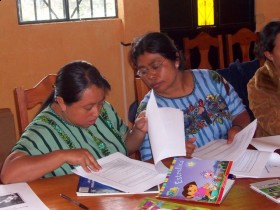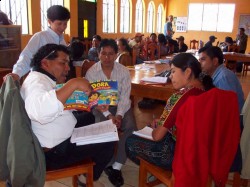
Teacher training is a key component of Child Aid’s programs in Guatemala, a country where most rural teachers have only the equivalent of a high school degree. Last week, a teacher approached Elba Arroyo, one of Child Aid’s regional coordinators who was assisting a librarian at the Melotto School, and asked her what is involved in getting teacher training at another school. Like many teachers in Guatemala the teacher works in two different schools at the same time, teaching in the morning at a primary school and in the afternoon at a middle school.
The teacher told Elba how affective the training has been for her and for her students. She said that she appreciated the tools she was given to promote reading with her students and that her students have asked for reading time every day since the she began implementing what she learned in the workshops. Considering the fact that most classrooms in rural Guatemala lack story books entirely, this is a huge step. The teacher also commented on how much she appreciates having the library at Melotto; without it, she said, she would not be able to provide storybooks to the kids each day (most of the books in Melotto’s library were donated by supporters of Child Aid).

The teacher told her colleagues in the afternoon school about the response of the students in her morning school (Melotto), and they have been asking how they can participate in the trainings. This is good news for Child Aid on many counts. We certainly believe that our workshops can make a difference in the lives of both teachers and students, but it takes implementation to make that happen. To hear that teachers are telling others about the material and skills they learn, and that other teachers want the same training is tremendously motivating to us.
This actually is not an isolated case. We have had several teachers tell us that colleagues at other schools want the training. The difficulty for us is to decide where and how to expand our workshops in the next year. The strain of resources combined with the hard-to-reach rural locations, and the intensity of the yearlong training (our training consists of 3 school-wide workshops and six individual follow-up sessions with each teacher) makes it necessary to be very strategic in choosing new schools to work in. We also want to work through local libraries so that the teachers and students have resources to draw upon to implement the workshop materials.

Another way new teachers are hearing about Child Aid is through university classes. Several of the primary teachers who want to become middle school or high school teachers take university classes in the evenings or weekends. We have had two of these teachers tell us that they have made presentations in their classes about the reading promotion techniques they have learned in our workshops. They have told us that other students have asked if we could come to the class and do our workshop for them.
We are always thrilled to hear of new inquiries about the workshops, but what really motivates us is hearing how the children are responding to the materials. The same teacher that asked Elba if we could work with her other school told Elba that her own daughter has now sparked an interest in reading (she is a student at Melotto, but in another class). She talks almost daily about the stories she is reading and has even begun bringing books home to read. None of this would have been possible a few years ago. Because Child Aid supporters have made it possible for us to invest time, money and resources in the Melotto school over the last several years, change is taking place and children and teachers are developing skills they did not have before – and these make a huge difference in their lives.